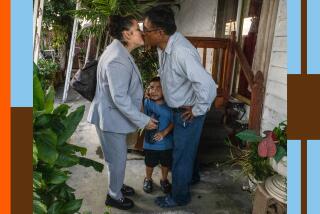In Baghdad, a sanctuary restored
Capt. Amy Cronin never had a pet. Before deploying to Iraq, she didn’t even really know much about animals.
But in 15 months, Cronin and her unit, the 15th Brigade Support Battalion, have gone from providing logistics and supplies to U.S. troops to helping refurbish an animal clinic, building horse stables and constructing new habitats for bears and porcupines at the Baghdad Zoo.
“It’s really satisfying,” said Cronin, 28, from Boiling Springs, Pa. “Typically support soldiers don’t get to interact with Iraqis as much as infantry would. And this gives me the satisfaction of seeing the direct results of my work.”
That has included projects to resuscitate the zoo, in a lush 3-square-mile park in the heavily fortified Green Zone, which also includes the headquarters of the U.S.-led coalition forces, the Iraqi parliament and other key administrative buildings. It used be among the largest animal sanctuaries in the Middle East.
The zoo had received assistance from U.S. civil affairs units, engineers and international animal aid agencies since the U.S.-led invasion of 2003. But some of the quarters for animals needed to be rebuilt and the park’s aesthetics needed improvement before it could be turned into a haven where Baghdad residents could retreat from the violence on the streets.
“We’re not making sure that people have water and other supplies [with this assignment], but we are making sure that people have a place to relax and have fun,” said Lt. Col. Jeffrey Vieira, the unit’s commander.
Before the war, the zoo, located in Zawra Park, was home to more than 500 animals, officials said.
Some of the animals escaped as mortar rounds slammed into the zoo during fighting between U.S. troops and the Iraqi Republican Guard.
After the fighting subsided, many of the smaller and tamer animals, such as goats and pigs, were stolen for food. More exotic creatures, such as rare species of birds, were sold on the black market or smuggled out of the country.
The zoo reopened in July 2003, and most of the employees returned. But fewer than 100 animals remained.
“It needed medical supplies, and power generation was an issue,” said Maj. David Shoupe, a public affairs officer with the 2nd Brigade of the 1st Cavalry Division, which includes the 15th Brigade Support Battalion.
The zoo was dependent on the city’s power supply, which meant it typically received electricity for only three hours a day.
So when the battalion assumed zoo duty in April of this year, it brought several generators to ensure the electrical supply.
Next came refurbishing of the clinic, which got new equipment, to the delight of the zoo’s 10 veterinarians.
Then, on Nov. 1, the zoo’s four bears got a new home, a large compound with natural vegetation and a more wildlife-friendly environment.
It was a dramatic change from the small cages with tile floors where they had previously been confined separately, said Wassem Sarih Ameen, the zoo’s chief veterinarian. The floors were hard on the bears’ feet, and one of the animals in particular had leg problems, he said.
“Now her health has changed,” Ameen said. “She walks better. Her legs are healing.”
This month, the support battalion unveiled a new indoor horse stable with 20 individual stalls, along with a washroom and a birthing area. Before the renovation, the horses had to share stalls in an area severely damaged by artillery fire.
Cronin, whose unit is in the process of returning to its base in Ft. Hood, Texas, said the zoo projects were being funded through a $2-million grant from the Army Commander’s Emergency Response Program. The city of Baghdad has provided about $500,000.
Word has spread that the number of animals has grown, and visitors are coming back.
Once again, there are about 500 animals, Vieira said, among them 250 species of birds. Some of the new animals were bought in Syria; among the others, camels, ostriches and swans were brought in from private reserves around Baghdad.
Several lions and a cheetah that used to belong to Saddam Hussein’s son Uday are among the major attractions. Some of the animals might seem odd for a zoo in another part of the world. For example, a caged black Labrador that many Iraqi visitors refer to as the “American dog” is a popular attraction.
Shoupe, the public affairs officer, said the Labrador is an object of fascination because it is a purebred, uncommon in Baghdad. But it is unclear why some Iraqis refer to the Lab, a breed prominent in many countries, as the “American dog.”
On an average day about 200 visitors come to the park, zoo officials said. But during the holiday season, the number can surge to a million in a week.
Adil Salman Mousa, the zoo’s director for 17 years, said the reason for the crowds can be summed up in one word: security. “This is the most important thing for visitors in the Baghdad area,” he said. “This is the only place where Iraqis in Baghdad can breathe.”
Before entering Zawra Park, cars are searched and visitors are frisked by the more than 120 Iraqi security personnel who protect the zoo. U.S. soldiers patrol the facility two to three times a week, Vieira said.
On a recent morning, Ali Abdul Hussein came to the zoo with a female friend because he said he wanted to find a place where they could stroll without fear of violence.
“I feel safe here. I feel relaxed,” said Hussein, 51, a taxi driver, as his wandered past a newly renovated porcupine habitat, the latest of Cronin’s renovation projects. “Before,” he said, recalling the days of Saddam Hussein, “we always felt that someone was watching and listening to us. We didn’t feel free.”
--
More to Read
Start your day right
Sign up for Essential California for news, features and recommendations from the L.A. Times and beyond in your inbox six days a week.
You may occasionally receive promotional content from the Los Angeles Times.







